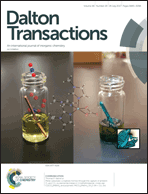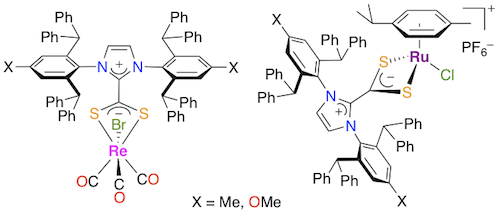"Synthesis and Complexation of Superbulky Imidazolium-2-dithiocarboxylate Ligands"
Tomás F. Beltrán, Guillermo Zaragoza, and Lionel Delaude
 |
source: Dalton Transactions
year: 2017
volume: 46
first page: 9036
last page: 9048
doi: 10.1039/c7dt01889d
|

Abstract: The superbulky N-heterocyclic carbenes (NHCs) 2,6-bis(diphenylmethyl)-4-methylimidazol-2-ylidene (IDip*Me) and its 4-methoxy analogue (IDip*OMe) reacted instantaneously with carbon disulfide to afford the corresponding imidazolium-2-dithiocarboxylate zwitterions in high yields. These new dithiolate ligands were fully characterized and their coordination chemistry toward common Re(I) and Ru(II) metal sources was thoroughly investigated. Neutral [ReBr(CO)3(S2C·NHC)] chelates featured three facially-arranged carbonyl groups on a distorted octahedron, whereas cationic [RuCl(p-cymene)(S2C·NHC)]PF6 complexes displayed a piano-stool geometry. The molecular structures of the six new compounds revealed that the NHC·CS2 inner salts were highly flexible. Indeed, the torsion angle between their anionic and cationic moieties varied between ca. 63° in the free ligands and 3° in the ruthenium complexes. Concomitantly, the S-C-S bite angle underwent a contraction from 131° to 110-113° upon chelation. Computation of the %VBur parameter showed that the dithiocarboxylate unit of the NHC·CS2 betaines chiefly determined the steric requirements of the imidazolium moieties, irrespective of the metal center involved in the complexation. The replacement of the p-methyl substituents of IDip*Me with p-methoxy groups in IDip*OMe did not significantly affect the ligand bulkiness. The more electron-donating methoxy group led, however, to small changes in various IR wavenumbers used to probe the electron donor properties of the carbene moiety.
[Full Text] [<< Previous Article] [Back to the List of Publications] [Next Article >>] l.delaude@ulg.ac.be